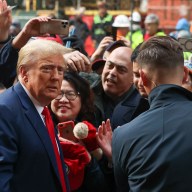Pins as a fashion statement for women: Boring? Not when Madeleine Albright wears them. For Albright, the former U.S. Secretary of State, brooches are a tool of diplomacy. Using a snappy brooch, she even taught Saddam Hussein something about respect.
Czech-born Albright made history when she became the United States’ first female Secretary of State, serving under former president Bill Clinton. Albright’s foreign-policy interest came naturally: Her father Josef Korbel, was a professor of international relations. Korbel has the unique distinction of being the man behind the USA’s first two female Secretaries of State. He discovered a talented student and made sure she earned a doctorate — her name: Condoleezza Rice.
Today Madeleine Albright heads the Albright Stonebridge Group, which advises companies and governments on international issues. Here, she answers questions about her famous brooches, diplomacy, and women working in the White House.
You often say that the purpose of foreign policy is to persuade others to do what we want, or even better, to want what we want. Are pins really an diplomatic tool?
I teach a course about what’s in the national security toolbox. The military is, of course, a very important national security tool, but I argue that pins belong in the toolbox, too.
You once wore a pin of a serpent to a meeting with Saddam Hussein. Why?
I often wore two pins, one dove and one eagle, in meetings to show that the U.S. was both willing to negotiate and to be tough. But Saddam had called me an unparallelled serpent, so I wore the pin to send the message that I couldn’t be put down. I think it showed toughness, but of course I didn’t get a chance to ask him for his interpretation.
Did your pins make any difference when dealing with Kim Jong Il?
At that time, the U.S. had no contact with North Korea. North Korea always said that the U.S. was terrible, despite the fact that we were sending lots of aid to them through the UN. So when I met with Kim Jong Il, I wore a huge pin of an American flag. I think he got the message.
What was your trickiest negotiation as Secretary of State?
Kim Jong Il. It was a departure from all negotiations we had previously conducted. The C.I.A. was telling us that he was crazy, while other sources said he was not. It was very difficult walking into complex negotiations without knowing whether you were dealing with a sane person. And I’m still not sure whether he’s sane or not.
You were the female U.S. Secretary of State, serving under Bill Clinton. How’s Mrs. Clinton doing in your old job?
The other day my seven-year-old granddaughter said to me. “Everybody keeps talking about how you were Secretary of State. What’s the big deal?” That shows you how far we’ve come — for little girls it’s no longer unusual to see a woman as Secretary of State. Hillary is doing a fantastic job with a difficult agenda. I thought we had a lot on our plate when I was Secretary of State, but she has to deal with a much wider variety of issues.
What’s the most useful skill you need to be successful in diplomacy?
The capability to absorb a lot of knowledge but also to understand what your national interests are — and the country’s national interests.
When do you use your diplomatic skills in everyday life?
When I negotiate with my grandchildren.
Would the world be a better place if women were in charge?
It would be better if more women were in office, but as far as peaceful goes: Just remember what high school was like.
















